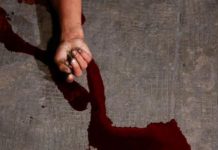EDITED EXCERPTS:
How did this book come about?
This project started in 2005 and went on till the end of 2011. It was on a family holiday in Gir in 2004 that I first saw the Sidi in Sirwan, a village in the middle of the forest given to the community by the [late] Nawab of Junagadh. I was intrigued and met my father’s childhood friend who had employed a Sidi. He became my guide and took me to the home of Sidi community leader Hirbaiben Lobi. Through her, I was able to photo graph her family and the larger community. Soon, I was travelling all over Gujarat, attending marriages, births, Urs celebrations and Goma dances, visiting dargahs, fields, homes and schools.
In 2006 in Surendranagar, I met Farida, an unmarried bank clerk from Bhavnagar who soon became my companion for the many of the Gujarat shoots. Clad in wedding attire with an elaborate hairstyle, she introduced me to the members of the community. I think it was at that wedding that I felt ready to embark on this project. Months later, at her great-grandfather’s grave in Bhavnagar, Farida pointed out an inscription from the Nawab that read “To my most loyal servant” and showed me her grandfather’s written account of a voyage by steamer to East Africa in the early ’70s called Maro Purwa Afrikano Pravas (My East African Journey). From Gujarat, I began travelling to Sidi villages in Karnataka, along with my friend Channa, a Sidi actor in the Ninasam troupe. The community here is a mix of Hindus and Christians unlike the Sufi Sidi of Gujarat and the Muslim Sidi in Bombay and Hyderabad. I rem ember sitting in a church with a Madonna and a cross in the middle of virgin forests, wondering how beautiful it must be to listen to the Sidi singing hymns in Kannada.
How did being an outsider affect your work?
I was an outsider from the day I entered the village of Jambur, and still very much am. My first trip to Jambur was without a camera. I had gone simply to meet the families living there. On reaching the village I encountered four boys dressed in T-shirts, baseball caps, studs in their ears, playing a serious game of carrom outside a chai stall. If looks could kill, I would be dead. There was a sense of irritation, anger, hostility and perhaps even resentment to this obvious outsider. However, a year later, two of the ‘angry’ boys, Majid and Husain, made their way into my book.
What did it take to integrate yourself with the community?
It did take a while to work around the villagers. Being a woman always helps, as it was the Sidi women who really took me in. They shepherded me around, introduced me to people and took me as far into the community as they could. One person who really opened her heart and home to me was Hirbaiben Lobi, the undisputed leader of the Sidi community in Jambur. She had won the Aga Khan award for leadership, perhaps that’s why she was used to outsiders and the press. She didn’t know how to read or write, but is the most expressive woman I have ever met. With Hirbaiben, I could follow her son Razzak through his courtship and his engagement to his lovely lady. A Sidi wedding means the entire village comes together, therefore I could meet and photograph many people. I hope my pictures survive as an archive of the Sidi, but I cannot take the responsibility of representing each moment of the community. Also, as a photographer, one has to be careful about the moments that belong to the camera and ones that don’t. I was in one household where there had been a death. The family was mourning for the person they had lost. I had my camera, but did not use it because that would have been an intrusion.
Do the Sidi living in Gujarat face challenges to their religion and identity?
The Sidi in Gujarat are Sufis. They are deeply religious but they are not fanatic. They are warm and generous. I am neither a scholar nor a political commentator, but as far as I could see, there is no resentment or politicisation. Also, I don’t think they are threatened by other communities. Yes, the Sidi are exclusive as a community, like many minorities. The Sidi in villages marry among themselves, and the more urban ones may marry into other Muslim communities. The Sidi life revolves around the dargah. The community comes together during Urs. Otherwise, every Thursday or Friday, they gather outside the dargah for an evening of informal prayers, dancing or just community chatter.
Of all the photographs, which one would you pick as a personal favourite?
The one captioned ‘Ramzana’. I was as much an object of curiosity to the Sidi as they were to me. I was in my mid-40s when I started this project. They would often ask me how many children I had and would be shocked when I told them that my daughter was only 10. When I asked Ramzana, a young woman who was expecting, if this was her first child. She laughed and told me that this was her fourth pregnancy. That moment of laughter is what I have been able to capture.













